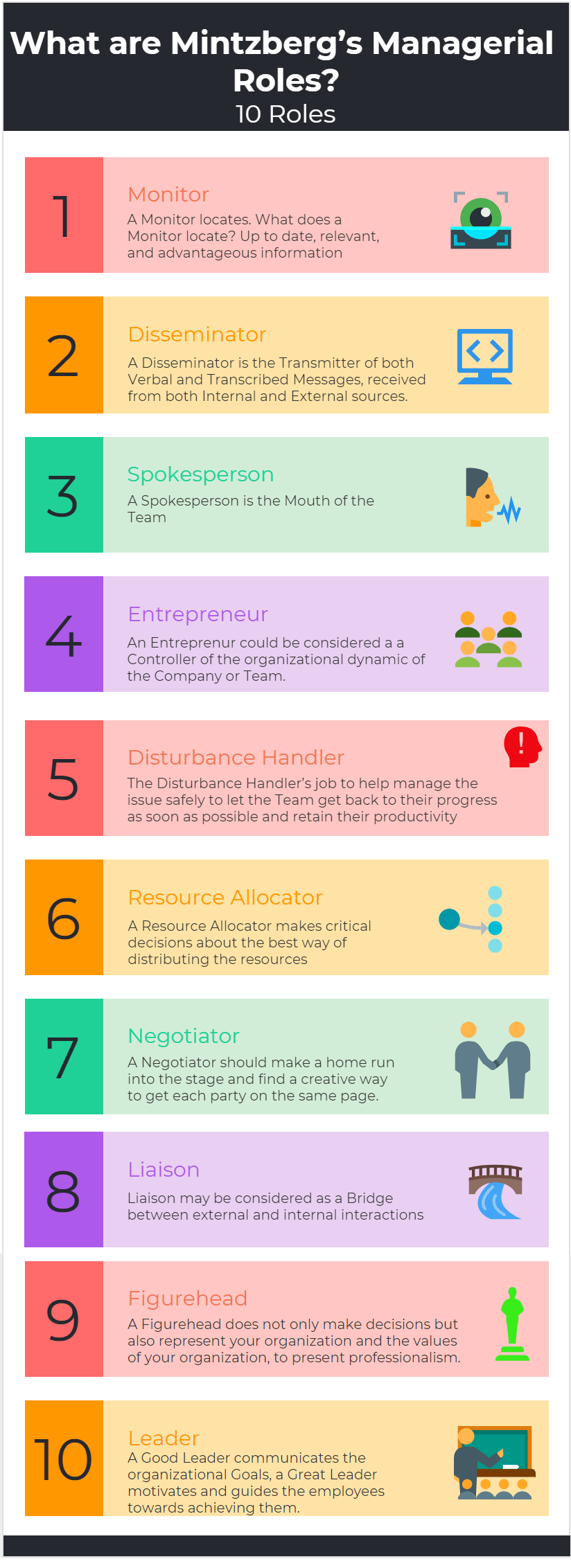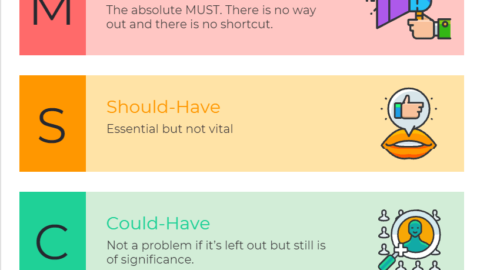Mintzberg’s Managerial Roles
Who is Henry Mintzberg? How many roles should a Great Manager have? What are Henry Mintzberg’s Managerial Roles? What are Henry Mintzberg’s Management Roles? How do Mintzberg’s Managerial Roles function? Do you know the 10 Managerial Roles developed by Henry Mintzberg?
Table of Contents
Dear Reader, welcome to another article about another great theory, only here for you at Project Cubicle.
In this article we are going to discuss Informational, Decisional and Interpersonal Roles of a Manager and explore how do the sub-roles of these roles add up to Henry Mintzberg’s 10 Managerial Roles.
Keep this one thing in mind.
Being a Manager is difficult.
A manager must have the necessary amount of knowledge about all Business Functions, Organizational Goals, Accountability, Service of Internal/External Clients, Communication Techniques, Conflict, Team, Risk, Change and Stakeholder Management, and countless more!
A Complete Business Person is Responsible For,
- Strategy
- Tactics
- Operations
Simple as these may sound, when you dive into its operations in the Business area, we discover that each of them carry its own complex responsibilities and characteristics. And this is the reason why a company employs different people for these responsibilities. No matter how interconnected they are, they consume enough time for a person to feel worked up. However, being a manager consists of having a piece of each to create the best pie!
For this reason…
At different times a Complete Business Person might need to act as:
- Problem Solver
- Strategic Planner
- Conflict Manager
- Realist
- Cheerleader
- Coach
- Organizer
- Liaison
- Optimist
- Decision Maker
- And more..
And it was what Mintzberg realised that helped him develop this theory!
What are Henry Mintzberg’s Managerial Roles?
Informational Roles
- Monitor
- Disseminator
- Spokesperson
Interpersonal Roles
- Entrepreneur
- Resource Allocator
- Disturbance Handler
Decisional Roles
- Negotiator
- Liaison
- Figurehead
- Leader
How Do Mintzberg’s Managerial Roles Function?
Henry Mintzberg thought that he could classify these roles under 3 categories: Interpersonal, Informational, and Decicisonal Roles.
One thing we should keep in mind: it is all about the processes of Information.
How?
When you think about it, Information is power. Exemplifying greater organizations like CIA, FBI, and the like were found to Acquire Information. These roles are likewise included in different processes in the applications of the obtained information.
Which ones?
1. Interpersonal Roles
Eliciting Information
a. Figurehead
You are an authority, people look up to you for inspiration, motivation, and growth and meanwhile there are social, legal, ceremonial or symbolic expectancies and responsibilites that you are obliged to fulfill. As a Figurehead, you do not only make decisions but also represent your organization and the values of your organization, to present professionalism.
b. Leader
A Good Leader communicates the organizational Goals, a Great Leader motivates and guides the employees towards achieving them.
We discussed Leadership thoroughly in our article about Leadership styles in Organizations. To briefly remind you, we’d like to step on what a Leader does for their Team.
A Leader,
- Communicates performance goals
- Trains & Mentors employees
- Supports their Team’s and Team Members’ Effort
- Supplies Resources
- Evaluates Employee Performance
- Motivates Employees Towards Higher Productivity
to ensure and monitor the progress of organizational goals and milestones.
c. Liaison
Liaison may be considered as a Bridge between external and internal interactions. At times, a Liaison acts like a Messenger and assists in the Communication process between internal and external members of the organization. As a Liaison, you are the key person in transefrring knowledge to your Stakeholders or Chain of Command as well. Moreover, you are also required to gain insight about your customer’s needs and carry that information to your Team so that they can make the necessary improvements in the product or process. This role, Liaison has a critical steo in reaching organizational goals, especially if the organization is of direct service to people.
2. Informational Roles
Processing Information
a. Monitor
A Monitor locates. What does a Monitor locate? Up to date, relevant, and advantageous Information. A Monitor is obliged to update themselves about the current industry standards of both internal and external business environments, in order to identify potential problems, risks and means of improvement, meanwhile also assessing the current dynamic of the organization to remain competitive and up to date in latest industry standards.
b. Disseminator
A Disseminator is the Transmitter of both Verbal and Transcribed Messages, received from both Internal and External sources. Generally, the received messages contain useful information that will assist the employees with guidance and efficient use of their time.
How? After you thoroughly researched what are the current industry trends are, you may have developed a potential product idea that might help increase revenue of the organization. As a Disseminator, your job is to share that idea with your Team as soon as possible to make the best out of it.
c. Spokesperson
Each Team has a Spokesperson. A Spokesperson is the Mouth of the Team. A Team completes the Tasks delegated by the Leader and Spokesperson is the one that makes internal and external presentations of the Team’s Current Status, Achieved Milestones, and Success.
A Spokesperson might be required to attend the Stakeholders’ Meetings and announce quantifiable results of the Team, while verbalizing the future Business Goals you intend to achieve within the year, month or week.
3. Decisional Roles
Utilising Information
a. Entrepreneur
While we were discussing Start Ups in our article, we explored the role of the person who creates a start up, commonly known the Entrepreneur. An Entrepreneur has to be the Jack of All Trades: should be capable of running organizational and business processes, implementing problem solving and novel strategies, searching for innovative and efficient methods to move forward, making critical decisions, developing a better or more effective marketing strategy, and countless more. An Entreprenur could be considered a a Controller of the organizational dynamic of the Company or Team.
b. Disturbance Handler
An unexpected roadblock? 3-2-1.. Action! It is now the Disturbance Handler’s job to help manage the issue safely to let the Team get back to their progress as soon as possible and retain their productivity. A Disturbance Handler must have Excellent Conflict Resolution Skills and these conflicts might be either internal (i.e., a conflict between colleagues), external (i.e., a customer wishes to back out from a contract), or both at the same time.
Disturbance Handler is required to keep these interruptions as short as possible and act quickly to get the Team back on business!
We can safely say that Disturbance Handler is at the backscene of all times to make an appearence at the stage if things do not go smoothly or as intended.
c. Resource Allocator
From the Funding of Equipment into Staffing Team Members.. Resource Allocator is in full charge! A Resource Allocator makes critical decisions about the best way of distributing these resources, at the Right Place, Right Time, and to Right People, and finally in the best division of the determined budget.
d. Negotiator
Negotiatons. One of the most important processes in an Organization. For a decision to be applied, each party has to be on the same page, whether it is a strategy or a short-term task, if all members of the Shareholders or Clients and the Shareholders are in disagreement, things might not go smoothly.
The parties will need to appeal to the each other’s common state of interests and needs in order to get that last signature or achieve that great increase in profit. However, if they can’t manage to have an agreement between each party, the division of that revenue will remain undetermined, and will result in making the Stakeholders discontent of the situation.
At times like these, a Negotiator should make a home run into the stage and find a creative way to get each party on the same page.
That is all you need to know about 10 Managerial Roles developed by Henry Mintzberg. Shall we remember what we have learned in this article?
10 Managerial Roles developed by Henry Mintzberg are a Frame of Reference when it comes to either Self or Business Development Goals.
Each Team contains a,
To assure that the business operations go smoothly and as intended.
Which one do you think is the most important in Business?
Which role do you think you employ in the Work Environment?
Would you like to see more content like this here at Project Cubicle?
Let us know in the comments below!
Thank you for reading this article.
Hope to see you soon in another article with another exciting subject!
External Reference











